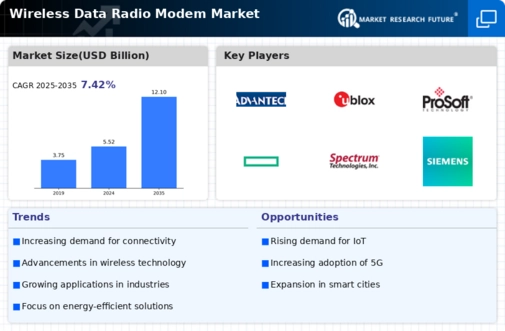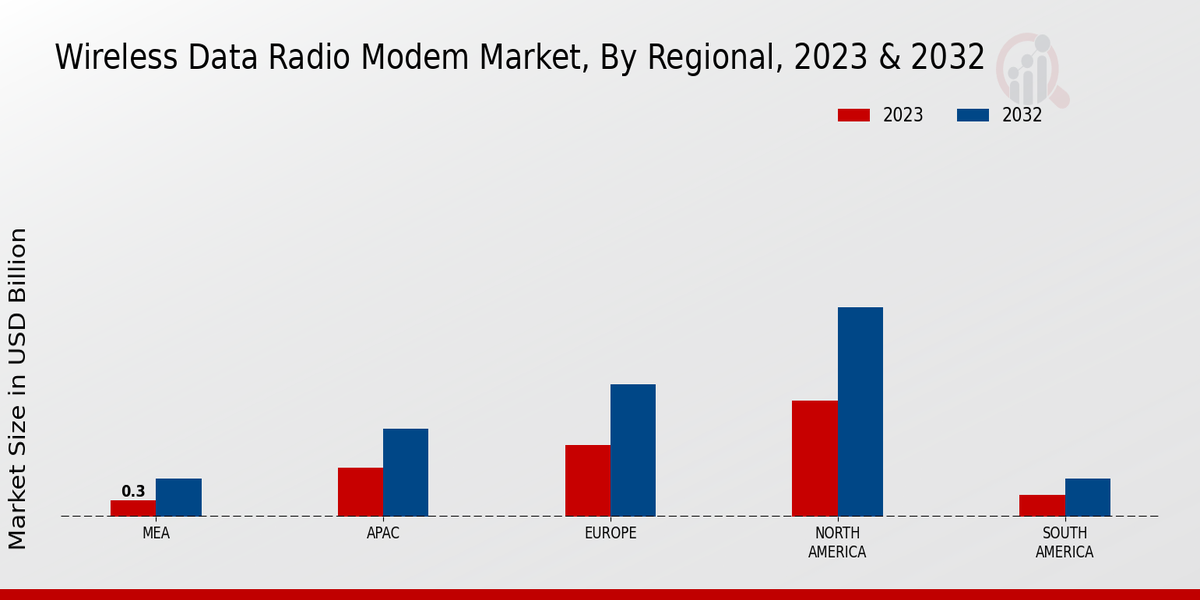Market Growth Projections
The Global Wireless Data Radio Modem Market Industry is projected to experience substantial growth, with estimates indicating a rise from 5.52 USD Billion in 2024 to 12.1 USD Billion by 2035. This growth trajectory suggests a compound annual growth rate (CAGR) of 7.41% from 2025 to 2035, reflecting the increasing demand for wireless data communication solutions across diverse sectors. The market dynamics are influenced by technological advancements, regulatory support, and the growing need for reliable data transmission in various applications. These projections highlight the potential for continued investment and innovation within the industry.
Expansion of Smart Grid Initiatives
The Global Wireless Data Radio Modem Market Industry benefits from the expansion of smart grid initiatives worldwide. Governments and utility companies are investing in modernizing energy infrastructure to improve efficiency and reliability. Wireless data modems play a crucial role in facilitating communication between smart meters, grid management systems, and consumers. This integration allows for real-time monitoring and management of energy consumption, contributing to sustainability goals. As the market evolves, it is projected to grow to 12.1 USD Billion by 2035, reflecting the increasing adoption of smart grid technologies.
Growing Demand for IoT Applications
The Global Wireless Data Radio Modem Market Industry experiences a surge in demand driven by the proliferation of Internet of Things (IoT) applications. As industries increasingly adopt IoT solutions for automation and data collection, the need for reliable wireless data transmission becomes paramount. This trend is particularly evident in sectors such as agriculture, transportation, and smart cities, where real-time data exchange is crucial. The market is projected to reach 5.52 USD Billion in 2024, reflecting the growing reliance on wireless data modems to facilitate seamless connectivity in IoT ecosystems.
Rising Need for Remote Monitoring Solutions
The demand for remote monitoring solutions significantly drives the Global Wireless Data Radio Modem Market Industry. Industries such as oil and gas, healthcare, and environmental monitoring require real-time data access from remote locations. Wireless data modems provide the necessary connectivity to transmit data from these sites to central systems, enabling timely decision-making and operational efficiency. This trend is likely to continue as organizations seek to optimize resource management and enhance safety protocols. The market's growth trajectory indicates a robust future, supported by the increasing reliance on remote monitoring technologies.
Regulatory Support for Wireless Communication
Regulatory support for wireless communication technologies plays a pivotal role in shaping the Global Wireless Data Radio Modem Market Industry. Governments worldwide are implementing policies that promote the deployment of wireless networks and enhance spectrum availability. Such initiatives facilitate the growth of wireless data modems by ensuring a conducive environment for innovation and investment. As regulatory frameworks evolve to accommodate emerging technologies, the market is expected to thrive, driven by increased adoption across various sectors. This supportive landscape may further accelerate the market's expansion in the coming years.
Advancements in Wireless Communication Technologies
Technological advancements in wireless communication significantly influence the Global Wireless Data Radio Modem Market Industry. Innovations such as 5G and advanced modulation techniques enhance data transmission speeds and reliability. These developments enable modems to support higher bandwidth applications, catering to the increasing data demands of various sectors. As industries transition to more sophisticated communication infrastructures, the market is poised for growth. The anticipated compound annual growth rate (CAGR) of 7.41% from 2025 to 2035 underscores the potential for wireless data modems to evolve alongside emerging technologies.












